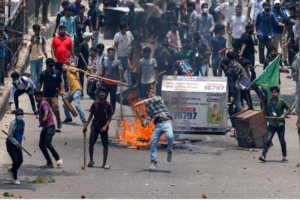Bangladesh is experiencing a historic shift.
Sheikh Hasina, the country’s long-serving prime leader, was overthrown by weeks of anti-government protests, and an interim administration is anticipated to be established.
Huge crowds flocked to Ms. Hasina’s official residence in Dhaka following her resignation and departure from the nation on Monday, amid allegations of looting and chaos in the city.
The violence claimed the lives of at least 20 more, bringing the total number of fatalities from Sunday’s demonstrations to almost 90, the highest number in Bangladesh’s recent history for a single day.
Ms. Hasina, a previous symbol of democracy who some claim turned more authoritarian over her 15-year rule, is currently in India. It’s unclear at this point if she intends to stay or move somewhere.

How did the protests begin?
Early in July, university students launched nonviolent protests calling for the removal of civil sector employment quotas, of which one-third are held by the family of veterans of Bangladesh’s 1971 war for independence from Pakistan.
The campaigners had maintained that the current system needed to be changed since it was discriminatory. Even though much of their desire was granted, the demonstrations quickly expanded into a larger anti-government movement.
According to Dr. Samina Luthfa, an assistant professor of sociology at the University of Dhaka, “it’s not [just] students anymore; it seems that people from all walks of life have joined the protest movement.” She said this to the BBC last month.
Conflicts erupted as the movement gained traction, and the disturbance claimed the lives of over 300 people.
Protesters and the media in Bangladesh held the police responsible for the increasing number of deaths. However, the government insisted that officers never fired unless in cases of self-defense or to defend state property.
In addition to imposing a statewide curfew and regularly cutting off internet connection in some areas of the country, Ms. Hasina called the people protesting against her “terrorists” who were trying to “destabilize the nation.”
However, the civil disobedience movement that had gained traction did not appear to be slowing down. Additionally, there was rising concern that greater violence would result from a protracted standoff.
Why were students angry?
Discontent was brewing for a long time in Bangladesh, and the protests didn’t happen in a vacuum.
Though the South Asian nation – which is home to 170 million people – was one of the fastest growing economies in the world, experts pointed out that growth had not translated into jobs for university graduates.
Estimates suggested that around 18 million young Bangladeshis were looking for jobs and university graduates faced higher rates of unemployment than their less-educated peers.
Bangladesh had become a powerhouse of ready-to-wear clothing exports. The country sold around $40 billion worth of clothes to the global market. The sector employed more than four million people, many of them women. But factory jobs were not sufficient for the aspiring younger generation.
And that’s partly why they wanted the quotas in government jobs to go – because that meant there would be more jobs for them.
Why did the protests grow?
The protests went beyond students even after the top courts overturned the quotas because Ms. Hasina’s government was the target of increased resentment due to the harsh crackdown.
Bangladesh had changed under her leadership, with new factories, bridges, roads, and even a metro train, but there were also claims of widespread corruption.
As more than 25 million people were pulled out of poverty over a 20-year period, per capita income tripled in the last ten years, according to the World Bank. However, many believed that the rise mostly benefited individuals in the PM’s Awami League.
“We are seeing a great deal of corruption,” Dr. Luthfa stated. notably among individuals who are connected to the governing party. For a very long period, corruption has existed without consequences.
The topic of corruption charges against several of Ms. Hasina’s former top officials, including a former army chief, an ex-police chief, senior tax authorities, and state recruitment officials, has taken center stage on Bangladeshi social media in recent months.
Benazir Ahmed, a former police commander and perceived close supporter of Ms. Hasina, was the subject of an ongoing investigation by the anti-corruption commission for accumulating millions of dollars. He refuted the accusations.
Ms. Hasina acknowledged that she had fired a home assistant for allegedly stealing $34 million in state monies, despite her vow to combat corruption.
Ordinary Bangladeshis, who had been struggling with the rising expense of life, were not immune to such stunning findings.
Rights groups said that under Ms. Hasina’s leadership, there had also been less room for democratic action. The government was charged with suppressing dissent, limiting the media and government critics, and imprisoning or expunging its most vocal opponents. However, clergy refuted the accusations.
According to Dr. Luthfa, “the resentment toward the ruling party and the government has been building for a long time.” “People are now expressing their rage. When they are left with no other options, people protest.





